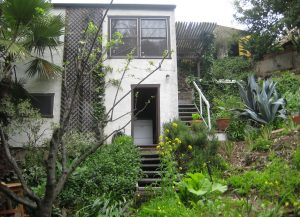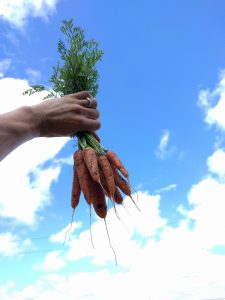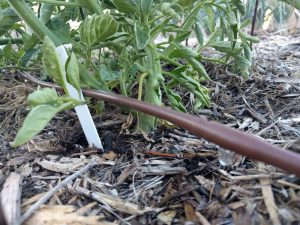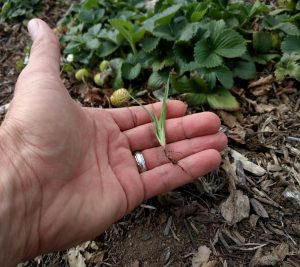The change I’d like to see in my corner of the world is that more people grow a little of their own food. It doesn’t require a lot of space, many tools, much physical effort or time or money.
Here I’ve gathered the five most useful things that I wish I had known when I started growing vegetables in Southern California. They have come to me through trying and failing, reading and observing, and trying some more. Maybe they can save you some time, money, headache, and backache.
1. Maximum sun
I wish I had known that if a garden spot gets at least six hours of full, direct, unimpeded sunlight, then you can grow any vegetable well. Under six hours, and you will struggle with some crops no matter how expertly you care for them otherwise.
How did I learn this? For the last seven years, I’ve been growing in a yard that gets eight hours of complete, open sun even on the shortest winter day (see photo at top). However, before here I grew my vegetables for years in a shady canyon (see below). The leap in health and production among my vegetables was apparent from the first day I planted in my current, sunny garden.
What should you do about this? Plant your vegetables wherever you have the most abundant sunlight. But also don’t be hard on yourself about disappointing results with certain crops, such as large tomatoes or watermelons, if your best spot has less than six hours of full sun.
More on this topic: See my post, “Where to plant a vegetable garden.”
2. Right timing
I wish I had known that you can’t plant any vegetable successfully at any time of year. Moreover, each vegetable has a different optimal planting window within which it will grow extremely easily.
How did I learn this? Over the years, I’ve tried planting about every vegetable at every time of year, and I’ve recorded the results.
What should you do about this? Follow the suggested sowing and planting dates of Southern California sources — not seed packets, and not general gardening books or websites.
More on this topic: See my post, “Which vegetables can I plant now in Southern California.” Also, see my post, “Oh, the mistakes I’ve made: Planting vegetables at the wrong time.” And consider getting one of my gardening calendars.
3. Natural soil building
I wish I had known that the best soil can be built by consistently spreading compost or other organic mulch on its surface — that’s all. No need to dig it in. And no need to buy and add emulsions of this, meals of that, fertilizer granules of what-what.
How did I learn this? I began gardening as a digger and a fertilizer. Bit by bit I adopted this simpler and more natural approach, and I now get as good or better results from my vegetable garden.
What should you do about this? Try it. You’ll never know until you try it.
More on this topic: See my post, “Fertile soil can be child’s play.” Also see my post, “Don’t dig in your garden.”
4. Watering by drip plus a little overhead
I wish I had known that drip irrigation is the best method for vegetables in Southern California, unless your garden is so small that you can easily water it by hand. Drip’s advantages are numerous. Yet it’s not perfect, and it is best supplemented by periodic overhead watering, which keeps some pests in check, and gives plants more wet soil to drink and eat from during summer heat.
How did I learn this? First, I sprinkled. Then, I dripped. Benefits included a 50% lower water usage, but the plants didn’t all do well until I began to occasionally spray the foliage and wet the soil surface during summer.
What should you do about this? Learn to use drip irrigation on your vegetables, and then every couple weeks or so through the summer, spray or sprinkle.
More on this topic: (See my post, “The best way to water a vegetable garden in Southern California.”)
5. Weed intelligently
I wish I had known that a few intelligent practices can almost eliminate the chore of future weeding.
How did I learn this? I used to just plant vegetables and water, and pull weeds. Then I got to know how weeds grow. These days I spend relatively little time dealing with them.
What should you do about this? Highlights: First, dig in your garden as little as possible. Second, mulch the surface. Third, pull weeds when they’re small. For weeds that get big, cut them off at the base and leave the roots in the soil. If the tops have seeds, remove them from the garden.
More on this topic: See my post, “How to outsmart garden weeds.”
Of course there are a hundred other lessons to be learned along the way about growing vegetables in Southern California. These five have made the biggest difference to me. With them we can start to garden smart — not expensive or hard — and eat food grown at home that is fresh, clean, and tasty, as it is supposed to be.
You might like to read these other posts:
Should you grow vegetables from seeds or plants?
How long to run drip irrigation on vegetables
The art of transplanting a vegetable seedling
Growing onions in Southern California
Growing carrots in Southern California
Growing potatoes in Southern California
What’s the best time of day to water your plants?
The economics of homegrown broccoli
The best way to support tomato plants
Get your hands dirty: Discover the truth about your irrigation practices









Awesome post!!! I’ll be referring to it often.
Great , simple info for starting my garden. I’ve never started this late, I’ll see how it goes!!
When you overhead spray your vegetable garden, how much do you water? Do you soak the mulch through to the soil surface?
Hi Laura,
Yes, when I overhead water my vegetables (about once a month, in between the normal drip irrigations), I water enough to soak through the mulch and into the dirt below. Usually, this requires 1-2 inches of water. I measure this by setting out tuna cans. (Filling a tuna can means applying about an inch of water.)
Can you grow winter squash in the fall/winter here in Southern California or is the term “Winter Squash” just for harvesting them to save for winter? I live in Mission Viejo and planted Blue Hubbard and Spaghetti Squash a month or so ago with the intention they will grow and produce throughout the fall and winter and they aren’d doing the best. The reason I am wondering is because I grew a bunch of pumpkins (that sprouted from my compost) in the spring through summer and just harvested them for Halloween decorations. Since pumpkins are a winter squash I’m a little confused. I also planted zucchini as an experiment to see if they will produce in the colder temps but I’m not having much luck, what do you think?
Hi Eric,
Those terms “winter squash” and “summer squash” are so often confusing. I wish people would stop using them entirely.
All squash are warm season plants. They’ll start sprouting from a compost heap every day of the year around here, but they’ll only produce if started spring or the first half of summer.
You grew those pumpkins that sprouted from your compost at the perfect time (starting in spring). The “winter” part is supposed to describe the fact that they’ll keep through the winter, so they’re the kind of squash that can still be eaten in winter, but not grown in winter. Since we have such a long growing season (it warms up much earlier than almost anywhere else in the U.S.), we can harvest these Halloween decorations in the middle of summer. Luckily, since they are extremely slow to rot, it’s easy to store them until Halloween and Thanksgiving.
I’ve had a turban squash on the fireplace hearth since July, just waiting to look appropriate in the fall.
Then the “summer” in summer squash (zucchini, yellow crookneck, etc.) refers to the fact that they are traditionally eaten in the summer because they don’t store well.
If you planted that zucchini back in the middle of summer, I’d think you should still be getting production now if the plant is in plenty of sun. But I’ve never tried to push zucchini into late fall so I’m not sure how long it might produce. I always get tired of eating it by the end of summer, and the plants start to succumb to powdery mildew as they get old, and I just give up.
But I’m not aware of any kind of squash that will produce through the winter in Southern California. I’d imagine you can get the plant to live through the winter no problem, just like tomatoes and peppers can, but I can’t imagine them producing fruit through the winter.
That makes sense, thanks for the reply…
This post is so helpful! Are they any books you recommend as a guide for SoCal gardening?
Thanks! My favorite books on gardening in Southern California can be found in this post: https://gregalder.one/yardposts/best-books-food-gardeners-southern-california/
Are there any fruits or vegetables that will grow well in a shady location? I’m near you in Rancho Bernardo.
Hi Tom,
This appears to be a simple, straightforward question but it is actually hard to answer. I should write a full post on it sometime.
Some reasons it is hard to answer are because there are degrees of shade, there are locations that have shade only in certain times of the year, and personal expectations can vary so much that one person’s satisfaction with a crop might be unsatisfactory to someone else.
That being said, based solely on my own experience, fruits that perform better in some shade compared to others include sour citrus (limes, lemons, kumquats), bananas, loquats, and cane berries (raspberries, blackberries, boysenberries).
Vegetables that perform better in some shade compared to others include lettuces, greens (chard, mustard, kale), peppers, dry beans (pinto, black, etc.), potatoes, cherry tomatoes, parsley, cilantro, garlic, and onion.
In southern California, veggies and flowers can be grown year-round. But not all grow in every season.
Do you have any tips about growing garlic and ginger?
Hey Greg,
I’m wanting to build a raised bed vegetable garden in my yard. What’s the best way to prepare the soil for the bed? I’ve seen videos where people start with layers of cardboard, tree trimmings , compost and worm compost to be more economical with the amount of soil they need.
Do you have any advice for the best combination of elements to reduce costs and give my plants the best environment?
What’s the best time of year to start building and laying in soil before planting? It’s the third week of January now and I’m eager to get going.
Many thanks in advance for any advice.
Hi Greg,
I was so happy to come across your blog posts. It’s challenging to grow things in Lake Elsinore.
We live in Lake Elsinore, and we have been trying hugelkultur beds using garden soil and compost on top, and eucalyptus and pine branches at the bottom. We have drip irrigation and have added one of those 30% sunblocking tarps to keep the sun from burning the plants during our long, hot summers.
We currently have 21 chickens, happily eating bugs and pooping.
Our plants, most raised from seed, are spindly and not growing. It’s not working well, and we’re trying to figure out why.
The way things are today, we really need to grow as much as we possibly can.
Any suggestions appreciated. 🙂
Hi Claire,
I have done some hugelkultur beds in the past and seen some in other yards, and I’ve seen that a challenge with them in Southern California is keeping the plants watered during summer. Water rapidly drains through those mounds. I’d guess that you, in Lake Elsinore, would need to water those plants every day in summer, even with the 30 percent shade cloth, maybe twice a day during heat waves like now.
As the mound ingredients decompose over the years, plants should perform better in them. That’s what has happened with mine, anyway.